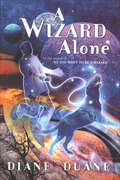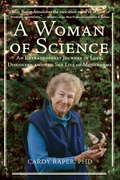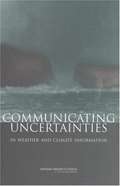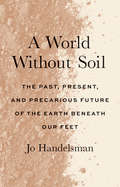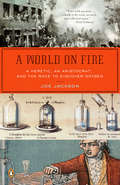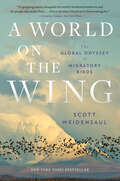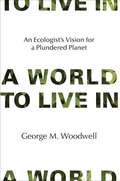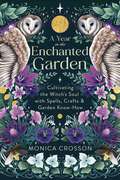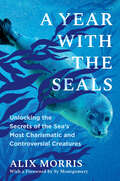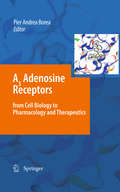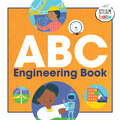- Table View
- List View
A Wilder Kingdom: Rethinking Nature in Zoos, Wildlife Parks, and Beyond
by Ben A. Minteer and Harry W. GreeneZoos have always had a troubled relationship to what is considered the “real” wild. Even the most immersive and naturalistic zoos, critics maintain, are inherently contrived and inauthentic environments. Zoo animals’ diet, care, and reproduction are under pervasive human control, with natural phenomena like disease and death kept mostly hidden from public view. Furthermore, despite their growing commitment to conservation and education, zoos are entertainment providers that respond to visitors’ expectations and preferences. What would a “wilder” zoo—one that shows the public a wider range of ecological processes—look like? Is it achievable or even desirable? What roles can or should zoos play in encouraging humanity to find meaningful connections with wild animals and places?A Wilder Kingdom is a provocative and reflective examination of the relationship between zoos and the wild. It gathers a premier set of multidisciplinary voices—from animal studies and psychology to evolutionary biology and environmental journalism—to consider the possibilities and challenges of making zoos wilder. In so doing, the contributors offer new insights into the future of the wild beyond zoos and our relationship to wild species and places across the landscape in an increasingly human-dominated era.
A Wizard from the Start
by Don BrownA wizard from the start, Thomas Edison had a thirst for knowledge, taste for mischief, and hunger for discovery—but his success was made possible by his boundless energy. At age fourteen he coined his personal motto: “The More to do, the more to be done,” and then went out anddid: picking up skills and knowledge at every turn. When learning about things that existed wasn't enough, he dreamed up new inventions to improve the world. From humble beginnings as a farmer’s son, selling newspapers on trains and reading through public libraries shelf by shelf, Tom began his inventing career as a boy and became a legend as a man.
A Wizard: The Sixth Book In The Young Wizards Series (Young Wizards Ser. #6)
by Diane DuaneWhile Nita grieves over her mother's death, Kit tackles a challenge as dangerous as it is strange: Rescue a young wizard who has vanished on his first assignment. This new wizard is unlike any other--he's autistic and he's a magical prodigy. His power is enormous. Now Kit and his dog, Ponch, must track down the missing boy before the Lone Power finds him.
A Woman of Science
by Cardy Raper Remeline DamascoA STORY OF TRUE LOVE, DETERMINATION, SACRIFICE, AND DISCOVERY.A Woman of Science catalogues a decades-long journey of inspirational hardship and success that serves as a model for what women can do in a field largely dominated by men.Cardy Raper succeeded in becoming what she dreamed of as a young girl: a scientist. This beautifully written memoir details her struggles with the "boys' club" mentality of the scientific and academic worlds, her grief over her husband's premature passing, and above all her relentless, passionate efforts to unlock the secrets of mushroom gender and reproduction.Cardy Raper is not a woman to accept "no" for an answer. When her mother told her that she could be a nurse when she grew up, Cardy informed her in no uncertain terms that she was going to be a true scientist, making grand discoveries. Science was a man's world then. But despite lack of encouragement through college, Cardy learned what she needed. Then, at the University of Chicago, she met her mentor, John "Red" Raper, an equally stubborn and spirited scientist. They became soul mates, and, together, studied sexual reproduction in the amazing water mold Achlya. Cardy and Red married, had children, and continued to share their passion for science by unraveling the means of sexual reproduction in mushroom-bearing fungi. They moved to Harvard University and continued their research. Years later, Red's untimely death left Cardy alone in the competitive world of cutting-edge science. But Cardy carried on. She achieved her doctoral degree, learned the techniques of molecular genetics, and established her own laboratory. Ultimately, Cardy's discoveries helped to uncover the way in which genes found throughout the animal kingdom--including humans--encode molecules for mating, sight, smell, and taste.
A Workshop Summary Communicating Uncertainties in Weather and Climate Information
by Elbert W. FridayThe report explores how best to communicate weather and climate information by presenting five case studies, selected to illustrate a range of time scales and issues, from the forecasting of weather events, to providing seasonal outlooks, to projecting climate change.
A World Environment Organization: Solution or Threat for Effective International Environmental Governance? (Global Environmental Governance)
by Frank BiermannIn recent years, the debate on the establishment of a new international agency on environmental protection - a 'World Environment Organization' - has gained substantial momentum. Several countries, including France and Germany, as well as a number of leading experts and senior international civil servants have openly supported the creation of such a new international organization. However, a number of critics have also taken the floor and brought forward important objections. This book presents a balanced selection of articles of the leading participants in this debate, including both major supporters and opponents of creating a World Environment Organization. The volume is especially relevant to students and scholars of international relations, environmental policy and international law, as well as to practitioners of diplomacy, international negotiations, and environmental policy making.
A World Without Ice
by Henry PollackA cowinner of the 2007 Nobel Peace Prize offers a clear-eyed explanation of the planet's imperiled ice. Much has been written about global warming, but the crucial relationship between people and ice has received little focus-until now. As one of the world's leading experts on climate change, Henry Pollack provides an accessible, comprehensive survey of ice as a force of nature and the potential consequences as we face the possibility of a world without ice. A World Without Ice traces the effect of mountain glaciers on supplies of drinking water and agricultural irrigation, as well as the current results of melting permafrost and shrinking Arctic sea ice-a situation that has degraded the habitat of numerous animals and sparked an international race for seabed oil and minerals. Catastrophic possibilities loom, including rising sea levels and subsequent flooding of low-lying regions worldwide. A World Without Ice answers our most urgent questions about this pending crisis, laying out the necessary steps for managing the unavoidable and avoiding the unmanageable.
A World Without Soil: The Past, Present, and Precarious Future of the Earth Beneath Our Feet
by Jo HandelsmanA celebrated biologist's manifesto addressing a soil loss crisis accelerated by poor conservation practices and climate change &“Jo Handelsman is a national treasure, and her clarion call warning of a looming soil-loss catastrophe must be heard. Add her clearly written alarm to other future-shocks: climate change, pandemics, and mass extinctions.&”—Laurie Garrett, Pulitzer Prize winner and author of The Coming Plague: Newly Emerging Diseases in a World out of Balance &“The ground beneath our feet is slipping away as we lose the precious soil that sustains us. Jo Handelsman&’s writing—as rich and life supporting as the soil itself—is a riveting warning.&”—Alan Alda, actor, writer, and host of the podcast &“Clear+Vivid with Alan Alda&” This book by celebrated biologist Jo Handelsman lays bare the complex connections among climate change, soil erosion, food and water security, and drug discovery. Humans depend on soil for 95 percent of global food production, yet let it erode at unsustainable rates. In the United States, China, and India, vast tracts of farmland will be barren of topsoil within this century. The combination of intensifying erosion caused by climate change and the increasing food needs of a growing world population is creating a desperate need for solutions to this crisis. Writing for a nonspecialist audience, Jo Handelsman celebrates the capacities of soil and explores the soil-related challenges of the near future. She begins by telling soil&’s origin story, explains how it erodes and the subsequent repercussions worldwide, and offers solutions. She considers lessons learned from indigenous people who have sustainably farmed the same land for thousands of years, practices developed for large-scale agriculture, and proposals using technology and policy initiatives.
A World Without Time: The Forgotten Legacy of Gödel and Einstein
by Palle YourgrauFor 15 years two men, one made like a rapier, the other looking like a pile of laundry, walked together to their respective homes through the Princeton campus, talking as only consummate academics can. In his last years on earth, Einstein would go to his office just to have these walks home. Perhaps he could see a future in which Gödel, the rapier and the world's greatest logician, would run out of time and leave this planet weighing, by his own choice, only 65 pounds. In their walks Gödel concluded that time, which Einstein showed not to exist on theoretical worlds, did not exist in this one either. Yourgrau (philosophy, Brandeis U. ) explains the time they had together, and how Gödel's resulting paper on this crucial aspect of relativity has fared amongst physicists and philosophers. Annotation ©2004 Book News, Inc. , Portland, OR (booknews. com)
A World in a Drop of Water: Exploring with a Microscope (Dover Children's Science Books)
by Alvin Silverstein Virginia SilversteinThis inexpensive volume showcases an array of curious creatures: a blob-like amoeba; a slipper-shaped paramecium and its mortal enemy, the suctorian; and many others. The authors recount the feeding, reproductive, and defensive strategies employed by these animals in easy-to-understand language that opens the door to a wonderful world of discovery. 37 illustrations.
A World of Color: The Science of Color in Everyday Life (Copernicus Books)
by David CannThis book demystifies the intricate science behind the colors that surround us every day, making it accessible to readers of all backgrounds, from the crackling warmth of campfires to the iridescent glow of butterfly wings. Have you ever wondered why the sky appears blue, or why leaves turn golden in the fall? How do our eyes perceive color, and why do some creatures see the world in hues we can only imagine? Delve into the captivating world of color with this informative and engaging book as your guide. A rich assortment of colorful figures and photographs accompanies you on a journey from the tranquil depths of the ocean to the shimmering neon lights of the urban cityscape. You'll learn how things like fluorescence, refraction, and interference allow artists to manipulate color to evoke emotion, and how scientists harness it to revolutionize technology. How does the color of fireflies inspire cutting-edge display devices, and what can the mantis shrimp teach us about the evolution of color vision? Prepare to be dazzled as you embark on a journey through the spectrum of discovery. Are you ready to see the world in a new light?
A World on Fire
by Joe JacksonThe discovery of oxygen in the late 1700s changed human thought & history radically. Yet its discovery began quietly, with the survival of a mouse under a lab. bell jar. This re-creation of these events takes us back to the final decades of the 1700s & the waning days of the Enlightenment. The English heretic & the French aristocrat who simultaneously isolated oxygen could not have been an unlikelier pair. Joseph Priestley was a tinkerer who knew Ben Franklin, John Adams, & Thomas Jefferson, to whose new nation he eventually fled. Antoine Lavoisier was rich & sophisticated, yet his path ended at the guillotine. Both Priestley & Lavoisier would see their works & lives destroyed, & never know how profoundly they changed the future. Illustrations.
A World on the Wing: The Global Odyssey Of Migratory Birds
by Scott WeidensaulNew York Times Bestseller Finalist for the Los Angeles Times Book Prize A Library Journal Best Science and Technology Book of the Year An exhilarating exploration of the science and wonder of global bird migration. In the past two decades, our understanding of the navigational and physiological feats that enable birds to cross immense oceans, fly above the highest mountains, or remain in unbroken flight for months at a stretch has exploded. What we’ve learned of these key migrations—how billions of birds circumnavigate the globe, flying tens of thousands of miles between hemispheres on an annual basis—is nothing short of extraordinary. Bird migration entails almost unfathomable endurance, like a sparrow-sized sandpiper that will fly nonstop from Canada to Venezuela—the equivalent of running 126 consecutive marathons without food, water, or rest—avoiding dehydration by "drinking" moisture from its own muscles and organs, while orienting itself using the earth’s magnetic field through a form of quantum entanglement that made Einstein queasy. Crossing the Pacific Ocean in nine days of nonstop flight, as some birds do, leaves little time for sleep, but migrants can put half their brains to sleep for a few seconds at a time, alternating sides—and their reaction time actually improves. These and other revelations convey both the wonder of bird migration and its global sweep, from the mudflats of the Yellow Sea in China to the remote mountains of northeastern India to the dusty hills of southern Cyprus. This breathtaking work of nature writing from Pulitzer Prize finalist Scott Weidensaul also introduces readers to those scientists, researchers, and bird lovers trying to preserve global migratory patterns in the face of climate change and other environmental challenges. Drawing on his own extensive fieldwork, in A World on the Wing Weidensaul unveils with dazzling prose the miracle of nature taking place over our heads.
A World to Live In
by George M. WoodwellA century of industrial development is the briefest of moments in the half billion years of the earth's evolution. And yet our current era has brought greater changes to the earth than any period in human history. The biosphere, the globe's life-giving envelope of air and climate, has been changed irreparably. In A World to Live In, the distinguished ecologist George Woodwell shows that the biosphere is now a global human protectorate and that its integrity of structure and function are tied closely to the human future. The earth is a living system, Woodwell explains, and its stability is threatened by human disruption. Industry dumps its waste globally and makes a profit from it, invading the global commons; corporate interests overpower weak or nonexistent governmental protection to plunder the planet. The fossil fuels industry offers the most dramatic example of environmental destruction, disseminating the heat-trapping gases that are now warming the earth and changing the climate forever. The assumption that we can continue to use fossil fuels and "adapt" to climate disruption, Woodwell argues, is a ticket to catastrophe.But Woodwell points the way toward a solution. We must respect the full range of life on earth -- not species alone, but their natural communities of plant and animal life that have built, and still maintain, the biosphere. We must recognize that the earth's living systems are our heritage and that the preservation of the integrity of a finite biosphere is a necessity and an inviolable human right.
A World to Live In: An Ecologist's Vision for a Plundered Planet
by George M. WoodwellA scientist makes a powerful case that preservation of the integrity of the biosphere is a necessity and an inviolable human right.A century of industrial development is the briefest of moments in the half billion years of the earth's evolution. And yet our current era has brought greater changes to the earth than any period in human history. The biosphere, the globe's life-giving envelope of air and climate, has been changed irreparably. In A World to Live In, the distinguished ecologist George Woodwell shows that the biosphere is now a global human protectorate and that its integrity of structure and function are tied closely to the human future. The earth is a living system, Woodwell explains, and its stability is threatened by human disruption. Industry dumps its waste globally and makes a profit from it, invading the global commons; corporate interests overpower weak or nonexistent governmental protection to plunder the planet. The fossil fuels industry offers the most dramatic example of environmental destruction, disseminating the heat-trapping gases that are now warming the earth and changing the climate forever. The assumption that we can continue to use fossil fuels and “adapt” to climate disruption, Woodwell argues, is a ticket to catastrophe.But Woodwell points the way toward a solution. We must respect the full range of life on earth—not species alone, but their natural communities of plant and animal life that have built, and still maintain, the biosphere. We must recognize that the earth's living systems are our heritage and that the preservation of the integrity of a finite biosphere is a necessity and an inviolable human right.
A Year Like No Other: How a Global Pandemic Led to Vanderbilt University's Proudest Moment
by Ryan UnderwoodThe University that was at the heart of the research to discover the vaccines for the pandemic pens the story of how it all happened.In 2020, as COVID-19 threw the U.S. higher education system into turmoil, university administrators around the country debated whether it was prudent—or even possible—to teach students in person or conduct laboratory research amid a once-in-a-century pandemic. For the leadership at Vanderbilt University, the answer to the question was a resounding Yes. Viewing residential education and collaborative research as essential to its academic and societal mission, Vanderbilt was one of a small number of America&’s top universities to put rigorous safety protocols in place to allow students, faculty, and research personnel back to campus in the fall. Told with recollections and insights from Vanderbilt&’s leaders, students, faculty, and staff, and moving at a pace matching the events it describes, A Year Like No Other takes readers from Vanderbilt&’s near-shutdown in the spring through its reopening for the 2020–2021 academic year, providing an inside look at how the university coped not only with COVID-19, but also with a tragic night of tornadoes and the urgent calls for racial justice following the killing of George Floyd. A Year Like No Other also highlights some of the vital contributions that faculty at Vanderbilt and Vanderbilt University Medical Center have made to the development of COVID-19 vaccines and therapies, with research fueled in part by Dolly Parton, the beloved country music legend. A Year Like No Other captures a singular moment in the university&’s history while delivering a concise portrait of successful crisis management playing out amid the fast-changing circumstances of global health threats and a barrage of local hardships.
A Year in the Enchanted Garden: Cultivating the Witch's Soul with Spells, Crafts & Garden Know-How
by Monica CrossonStep onto the Garden Path with a Year of Spells, Stories & SoilDig into your Witchcraft with month-by-month gardening guidance for flowers, herbs, vegetables, trees, and more. Featuring dozens of spells, charms, and activities, this hands-on book helps you select, grow, and harvest the best plants for your region and shows you how to use them in your magickal practice.Monica Crosson devotes three chapters to each month, sharing both practical and magickal tips on timely garden tasks. Her inviting collection blooms with stories, recipes, and crafts as well as correspondences for stones, colors, animals, zodiac signs, and more.Deepen your connection to Mother Nature with thirteen Celtic tree month full moon rituals. Revel in the rich folklore, sabbat celebrations, and garden-based deities. Whatever hardiness zone you hail from, A Year in the Enchanted Garden will nurture your love of plants and guide you through growing your most plentiful garden yet.
A Year with Nature: An Almanac
by Marty Crump Bronwyn McIvorA Year with Nature is an almanac like none you’ve ever seen: combining science and aesthetics, it is a daily affirmation of the extraordinary richness of biodiversity and our enduring beguilement by its beauty. With a text by herpetologist and natural history writer Marty Crump and a cornucopia of original illustrations by Bronwyn McIvor, this quirky quotidian reverie gazes across the globe, media, and time as it celebrates date-appropriate natural topics ranging from the founding of the National Park Service to annual strawberry, garlic, shrimp, hummingbird, and black bear festivals. With Crump, we mark the publication of classics like Carson’s Silent Spring and White’s Charlotte’s Web, and even the musical premiere of Tchaikovsky’s Swan Lake. We note the discovery of the structure of DNA and the mountain gorilla, the rise of citizen science projects, and the work of people who’ve shaped how we view and protect nature—from Aristotle to E. O. Wilson. Some days feature US celebrations, like National Poinsettia Day and National Cat Day; others highlight country-specific celebrations, like Australia’s Wombat Day and Thailand’s Monkey Buffet Festival, during which thousands of macaques feast on an ornately arranged spread of fruits and vegetables. Crump also highlights celebrations that span borders, from World Wildlife Conservation Day to International Mountain Day and global festivities for snakes, sea turtles, and chocolate. Interweaving fascinating facts on everything from jellyfish bodies to monthly birth flowers with folkloric entries featuring the Loch Ness Monster, unicorns, and ancient Greek, Roman, and Egyptian mythology, the almanac is as exhaustive as it is enchanting. A Year with Nature celebrates the wonder and beauty of our natural world as we have expressed it in visual arts, music, literature, science, natural history, and everyday experience. But more than this, the almanac’s vignettes encourage us to contemplate how we can help ensure that future generations will be able to enjoy the landscapes and rich biodiversity we so deeply cherish.
A Year with the Seals: Unlocking the Secrets of the Sea's Most Charismatic and Controversial Creatures
by Alix MorrisEnvironmental journalist Alix Morris spends an eye-opening year getting to know these elusive, intelligent creatures, investigating the effects of their extraordinary return from the brink of extinction and how we can try to bring nature back into balance. It might be their large, strangely human eyes or their dog-like playfulness, but seals have long captured people's interest and affection, making them the perfect candidate for an environmental cause, as well as the subject of decades of study. Alix Morris spends a year with these magnetic creatures and brings them to life on the page, season by season, as she learns about their intelligence, their relationships with each other, their ecosystems, and the changing climate. Morris also gets to know all of the competing interests in the intense debate about the newly recovered seal populations in our coastal waters, from local fishermen whose catch is often diminished by savvy seals, to tribes who once relied on seal-hunting for food, clothing, and medicine, to seal rescue workers and biologists, to surfers and swimmers now encountering seal-hunting sharks in coastal waters. A Year with the Seals is a rare look at what happens when conservation efforts actually work, and how human tampering with ecosystems continues to have unexpected consequences. But it&’s also a gripping adventure story of a journalist determined to understand seals and our relationship with them for herself.
A Zebra's Day (Readers)
by Aubre AndrusFollow a zebra throughout the day as it grazes and spends time with its herd in its grassland habitat.Zebras are one of Africa's most interesting animals, and in this pre-reader, young readers will learn all about where they live, what they eat, and how they survive in the herd. Perfect for beginning and young readers, National Geographic Pre-readers include simple, expert-vetted text and large, engaging photos on every page. A vocabulary tree at the beginning of the book introduces kids to key words in concept groups, helping them make connections between words. Plus, a wrap-up activity gives kids a chance to use what they've learned, while expanding their knowledge of the world.
A salvo en la red
by Francisco Castaño Mena Pedro García AguadoDe la mano de Pedro García Aguado y Francisco Castaño Mena llega el tercer volumen del proyecto «Aprender a educar», centrado esta vez en un tema tan preocupante, complejo y actual como el modo en que debemos proteger a nuestros hijos en internet y las redes sociales. <p><p>¿Cuándo debo comprarle un smartphone a mi hijo? ¿Tengo que establecer unas normas de uso? ¿Cómo le protejo de los riesgos de internet? ¿Cómo controlo que no sufra o haga ciberbullying? Desde su proyecto «Aprender a educar», Pedro García Aguado y Francisco Castaño Mena hacen hincapié en la educación familiar como factor clave de protección para prevenir posibles dificultades con los hijos. En este tercer libro, los autores se adentran en las nuevas tecnologías y muestran a padres y profesores cómo educar en su uso. <p>A salvo en la Red es un manual indispensable para que niños y adolescentes reciban una buena educación digital y les enseñemos a utilizar estas herramientas sin riesgo y sacándoles el máximo partido. Con un lenguaje directo y cercano, los autores nos exponen casos reales de su consulta y nos enseñan que las nuevas tecnologías, usadas de forma correcta, pueden convertirse en grandes aliadas.
A vivir la ciencia: Las pasiones que despierta el conocimiento
by Pere EstupinyàPere Estupinyà vuelve a demostrar que la ciencia, bien explicada, no solo resulta interesantísima, sino que es la herramienta fundamental para mejorar el mundo y nuestra vida. Este libro es una invitación a descubrirnos a nosotros mismos y lo que nos rodea a través de la ciencia. Con historias sorprendentes y un estilo ameno, directo, apasionado, riguroso y divulgativo, Estupinyà amplía en estas páginas sus conversaciones dominicales junto a Javier Sampedro y Javier del Pino en el programa A Vivir de la Cadena SER con todo tipo de expertos en neurociencia, astrofísica, biología, paleontología, psicología, sociología, filosofía, tecnología, medioambiente y salud humana. Agrupadas según las emociones que le suscitan, transitaremos por la esperanza ante los pequeños milagros de la medicina; la introspección al explorar la psique humana; la diversión ante los temas más disparatados y entretenidos; la curiosidad al revelar los mundos más lejanos e invisibles; la indignación por la resistencia a aprovechar el conocimiento científico; la preocupación por la crisis climática y el deterioro del planeta; la inspiración para mejorar aspectos sociales gracias a los descubrimientos científicos; el asombro al ver que la realidad se acerca cada día más a la ficción; y la responsabilidad, porque el futuro no depende de la tecnología sino de nosotros los humanos. A Vivir la ciencia nace de la curiosidad, pero también es una llamada al cambio. Salpicado con apreciaciones personales del autor, es una reivindicación a pensar científicamente y a utilizar los pequeños milagros de la ciencia para el bien individual y colectivo.
A-Beta Metabolism and Alzheimer's Disease
by Takaomi Comings SaidoThis book provides information regarding three major aspects of Aβ metabolism: generation from its precursor, degradation within the brain, and transport out of the brain. It is useful for graduate students, post-doctoral fellows, and scientists both in this and other disciplines.
A3 Adenosine Receptors from Cell Biology to Pharmacology and Therapeutics
by Pier Andrea BoreaThis book, "A3 Adenosine Receptors from Cell Biology to Pharmacology and Therapeutics", documents the present state of knowledge of the adenosine A3 receptor. Adenosine A3 receptors are G protein-linked receptors that function in physiology and intracellular signaling and are involved in inflammatory responses and mediating cell proliferation and cell death. The A3 receptor is increasingly being recognized for its biological roles throughout the body, and many A3 receptor ligands have proven useful in elucidating peripheral and central pathologies. This book covers a wide range of information including data from studies of theoretical, molecular and cellular pharmacology, signal transduction, integrative physiology, new drug discoveries and clinical applications. The book includes sections on: A3 Adenosine Receptor signal transduction, adenosine Receptor medicinal chemistry, effects and therapeutic applications of Adenosine Receptors on tissues and organs, adenosine Receptors and inflammatory and auto-immune diseases, adenosine Receptors and cancer. The chapters in this book cover both fundamental science and relevant applications and provide an authoritative account of the current status of the field. "A3 Adenosine Receptors from Cell Biology to Pharmacology and Therapeutics" is an up to date and scientifically excellent source of information, attractive to basic and clinical scientists alike.
ABC Engineering Book (STEAM Baby for Infants and Toddlers)
by Dr. Natoshia Anderson MEdFuel a child's ABC learning through the power of S.T.E.A.M. Give your little engineer a jump-start with this fun, inspiring way to master their ABCs. From Aqueduct to Zone, ABC Engineering Book introduces young children to basic engineering concepts with each letter of the alphabet. This S.T.E.A.M.-themed ABC engineering book for kids features: Levels of discovery—Explore a tiered learning approach that grows with your child. Focus first on letters, then on words, and then on understanding concepts. Colorful images—This ABC engineering book has rich and vibrant illustrations that add to the learning and will keep your child engaged. Full S.T.E.A.M. ahead—Encourage a lifelong love of learning with all the books in the S.T.E.A.M. Baby Series. Out Now: ABC Science Book. Coming Soon: ABC Arts Book, ABC Math Book, ABC Technology Book. ABC Engineering Book makes learning the alphabet a fun, exciting adventure for any toddler.


